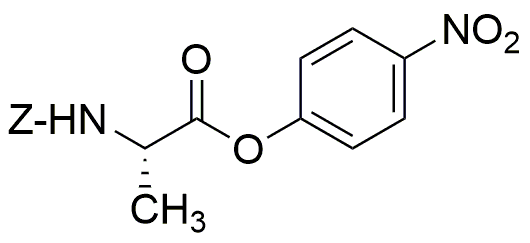Z-L-alanine 4-nitrophenyl ester is widely utilized in research focused on:
- Peptide Synthesis: This compound serves as a valuable building block in the synthesis of peptides, which are essential in drug development and biochemistry.
- Bioconjugation: It is used in bioconjugation processes to attach biomolecules to surfaces or other molecules, enhancing the functionality of drugs and diagnostics.
- Fluorescent Probes: The compound can be employed in the development of fluorescent probes for imaging applications, aiding researchers in visualizing cellular processes.
- Enzyme Inhibition Studies: It is useful in studying enzyme inhibition, providing insights into enzyme mechanisms and potential therapeutic targets.
- Drug Delivery Systems: This ester can be incorporated into drug delivery systems, improving the solubility and bioavailability of therapeutic agents.
Informations générales
Propriétés
Sécurité et réglementation
Applications
Z-L-alanine 4-nitrophenyl ester is widely utilized in research focused on:
- Peptide Synthesis: This compound serves as a valuable building block in the synthesis of peptides, which are essential in drug development and biochemistry.
- Bioconjugation: It is used in bioconjugation processes to attach biomolecules to surfaces or other molecules, enhancing the functionality of drugs and diagnostics.
- Fluorescent Probes: The compound can be employed in the development of fluorescent probes for imaging applications, aiding researchers in visualizing cellular processes.
- Enzyme Inhibition Studies: It is useful in studying enzyme inhibition, providing insights into enzyme mechanisms and potential therapeutic targets.
- Drug Delivery Systems: This ester can be incorporated into drug delivery systems, improving the solubility and bioavailability of therapeutic agents.
Documents
Fiches de données de sécurité (FDS)
La FDS fournit des informations de sécurité complètes sur la manipulation, le stockage et l’élimination du produit.
Spécifications du produit (PS)
Le PS fournit une description complète des propriétés du produit, notamment sa composition chimique, son état physique, sa pureté et les exigences de stockage. Il détaille également les plages de qualité acceptables et les applications prévues du produit.
Certificats d'analyse (COA)
Recherchez des certificats d'analyse (COA) en saisissant le numéro de lot du produit. Les numéros de lot et de lot se trouvent sur l'étiquette d'un produit, après les mots « Lot » ou « Lot de fabrication ».
Numéro de catalogue
Numéro de lot/série
Certificats d'origine (COO)
Ce certificat d'exploitation confirme le pays dans lequel le produit a été fabriqué, et détaille également les matériaux et composants utilisés et s'il est issu de sources naturelles, synthétiques ou autres sources spécifiques. Ce certificat peut être requis pour les douanes, le commerce et la conformité réglementaire.
Numéro de catalogue
Numéro de lot/série
Fiches de données de sécurité (FDS)
La FDS fournit des informations de sécurité complètes sur la manipulation, le stockage et l’élimination du produit.
DownloadSpécifications du produit (PS)
Le PS fournit une description complète des propriétés du produit, notamment sa composition chimique, son état physique, sa pureté et les exigences de stockage. Il détaille également les plages de qualité acceptables et les applications prévues du produit.
DownloadCertificats d'analyse (COA)
Recherchez des certificats d'analyse (COA) en saisissant le numéro de lot du produit. Les numéros de lot et de lot se trouvent sur l'étiquette d'un produit, après les mots « Lot » ou « Lot de fabrication ».
Numéro de catalogue
Numéro de lot/série
Certificats d'origine (COO)
Ce certificat d'exploitation confirme le pays dans lequel le produit a été fabriqué, et détaille également les matériaux et composants utilisés et s'il est issu de sources naturelles, synthétiques ou autres sources spécifiques. Ce certificat peut être requis pour les douanes, le commerce et la conformité réglementaire.


